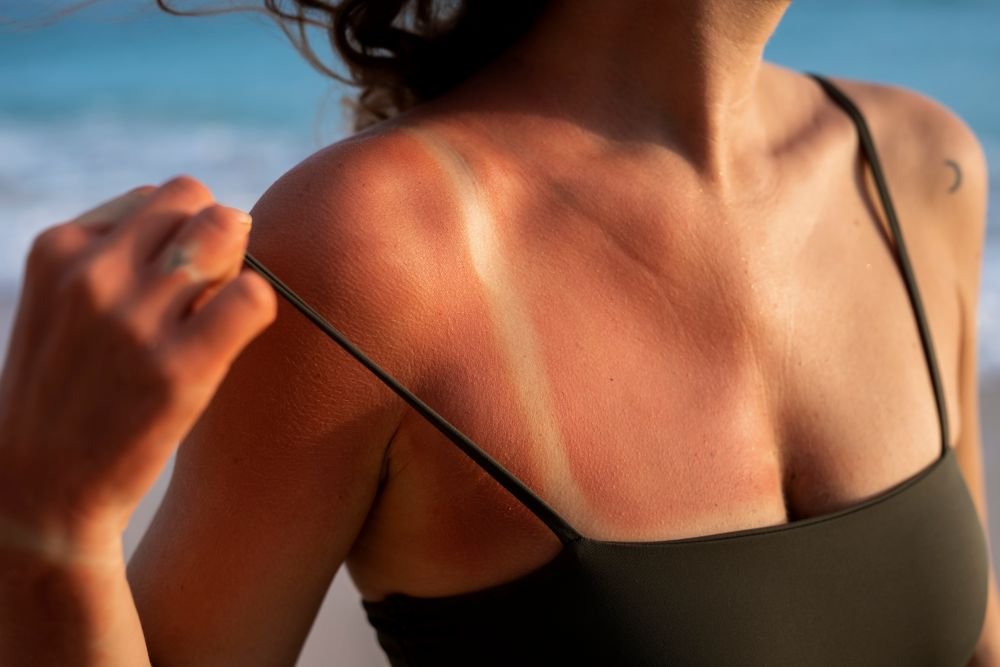Knowing how to prevent sunburn is crucial for anyone who enjoys spending time outdoors.
The damage caused by sunburn goes beyond just temporary discomfort; it can lead to more severe skin issues and increase the risk of skin cancer in the long run.
Table of Contents
The Importance of Sun Protection
Sunburn is not just a temporary discomfort; it can lead to severe skin damage and increase the risk of skin cancer. Understanding the importance of sun protection is the first step in safeguarding your skin.
Sunburn occurs when the skin is exposed to too much ultraviolet (UV) radiation, leading to skin cell damage and inflammation.
Over time, repeated sunburns can cause premature aging, sunspots, and an elevated risk of melanoma. Therefore, adopting a multi-faceted approach to sun protection is essential.
Renew Your Skin Like Never Before – Click to Explore this New Cell Renewal Formula!
Using Sunscreen Effectively
Choose the Right Sunscreen
When selecting a sunscreen, opt for one with a sun protection factor (SPF) of 30 or higher. This level of protection is necessary to block both UVA and UVB rays effectively.
Broad-spectrum sunscreens provide comprehensive coverage, ensuring your skin is shielded from various types of UV radiation.
Apply sunscreen generously to all exposed skin at least 15 minutes before heading outdoors. Don’t forget often-missed areas like the ears, back of the neck, and tops of the feet.
Reapply Frequently
Reapplying sunscreen is crucial, especially during prolonged sun exposure. Sunscreen’s effectiveness diminishes over time due to factors like sweating, swimming, and towel drying.
To maintain optimal protection, reapply every 2 hours and immediately after swimming or sweating.
Here are some key tips for effective sunscreen use:
- Apply a thick layer to all exposed skin.
- Use a water-resistant formula if swimming or sweating.
- Check the expiration date to ensure efficacy.
Transform Your Skin’s Texture – Explore this Advanced Cell Renewal Solution! – See the difference for yourself!
Seeking Shade and Covering Up
Protective Clothing

Wearing protective clothing is a simple yet effective way to prevent sunburn. Long sleeves, pants, wide-brimmed hats, and sunglasses can significantly reduce sun exposure.
Look for clothing with a UPF (Ultraviolet Protection Factor) rating for added protection.
Hats with wide brims provide shade for your face, neck, and ears, areas particularly vulnerable to sunburn. Sunglasses should offer 100% UV protection to shield your eyes from harmful rays.
Optimal Timing and Shade
Avoiding the sun during peak UV hours, typically between 10 am and 4 pm, can drastically reduce your risk of sunburn. If you need to be outside during these times, seek shade under trees, umbrellas, or canopies.
Creating your own shade can also be effective. Portable sun shelters or tents are great options for beach trips or outdoor events. Positioning yourself in naturally shaded areas can further enhance your protection.
The Risks of Tanning Beds and Sunlamps
Tanning beds and sunlamps might seem like a quick way to achieve a tan, but they pose significant risks. These devices emit concentrated UV radiation, which can lead to severe sunburn and increase the risk of skin cancer.
UV radiation from tanning beds can be more intense than natural sunlight, causing deeper skin damage. Regular use of these devices is linked to an elevated risk of melanoma, particularly in young adults.
It’s crucial to avoid these artificial tanning methods and embrace safer alternatives.
Exploring Natural Sunburn Preventives
Aroma Terpenes
Recent studies suggest that certain aroma terpenes, like β-damascenone and d-limonene, may help fortify the skin’s protective layers. These natural compounds can enhance the skin’s resilience against UV damage, potentially reducing the risk of sunburn.
While the research is promising, more studies are needed to confirm the efficacy and safety of aroma terpenes as sunburn preventives.
If you’re interested in exploring natural options, consult with a dermatologist to ensure they complement your overall sun protection strategy.
Benefits and Precautions
Incorporating natural sunburn preventives can be a valuable addition to traditional methods. However, it’s important to use them in conjunction with proven sun protection techniques like sunscreen and protective clothing.
Educating Children on Sun Safety
Teaching Sun-Safe Behaviors
Children are particularly vulnerable to sunburn, and early education on sun safety is crucial. Teach kids to wear hats, apply sunscreen, and seek shade during outdoor activities.
Role modeling is a powerful tool; children are more likely to adopt sun-safe behaviors when they see adults practicing them. Encourage consistent use of sunscreen and protective clothing from a young age to establish lifelong habits.
Parental Involvement
Parental education interventions can significantly reduce children’s sunburn risk. By educating parents on the importance of sun protection, you empower them to instill these practices in their children.
Consider these strategies to enhance sun safety education:
- Use fun, engaging methods to teach children about sun protection.
- Provide resources and reminders to parents about sun safety.
- Organize community events or workshops focused on sun safety education.
Conclusion about How to Prevent Sunburn This Summer
Preventing sunburn requires a comprehensive approach that combines multiple strategies. Using sunscreen effectively, seeking shade, wearing protective clothing, avoiding tanning beds, exploring natural preventives, and educating children are all critical components of a successful sun protection plan.
Remember, no single method can provide complete protection. By integrating various techniques and staying informed about the latest sun safety practices, you can enjoy the outdoors while keeping your skin healthy and sunburn-free.

